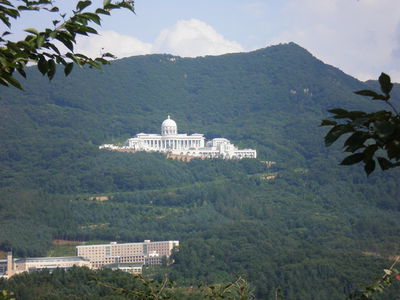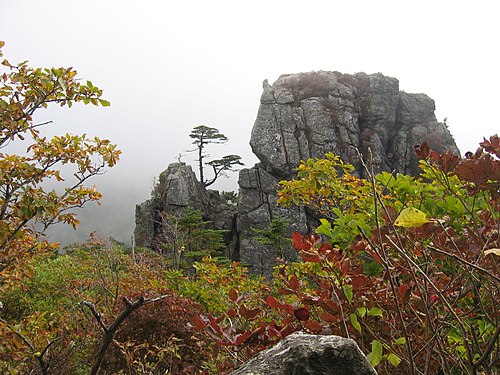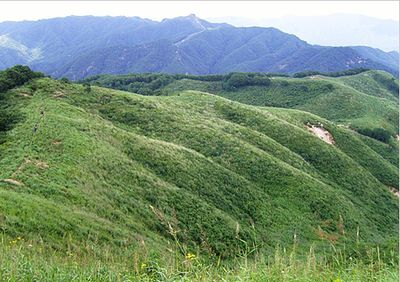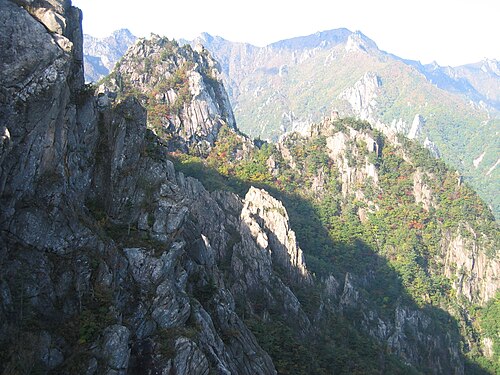Research page:Korean sacred sites
- This page contains preparatory information for the ERW main topic Korean sacred sites.
Baekdusan
This is a lake near the top of the highest mountain on the Korean peninsula and Manchuria.
The lake and mountain top are considered sacred. I learned about this mountain from an ancient Korean king who once united all the tribes on the peninsula ca. 8000 years ago (of course, he's in spirit world now, his name is Chin Yang). For them this mountain was the center and origin of Korea and connected to 12 other sacred places, one of them being Chung Pyung.[1]
Baekdu Mountain, also known as Changbai Mountain in China, is a volcanic mountain on the border between North Korea and China, located at 42°00′24″N 128°03′18″E / 42.00667°N 128.055°E / 42.00667; 128.055. At 2,744 m (9,003 ft), it is the highest mountain of the Changbai mountain range to the north and Baekdudaegan mountain range to the south. It is also the highest mountain on the Korean peninsula and Manchuria.
The Korean name, Baekdu-san (백두산, 白頭山; Korean pronunciation: [pɛk̚t͈usan]), means "white-headed mountain". The Chinese name, Changbai Shan (長白山/长白山), means "ever-white mountain". English-language volcanology resources often refer to the mountain as Baitoushan from the Chinese pinyin rendering of the Korean Hanja 白頭山. Other alternative names include Paektu-san and Bai Yun Feng.
A large crater lake, called Heaven Lake (Korean:천지, Chinese:天池), is located within the caldera atop the mountain.
The Baekdu Mountain has been worshipped by the surrounding peoples throughout history. Both the Koreans and Manchus (an ethnic group in China) consider it the place of their ancestral origin.
Location: 42° 0′ 20″ N, 128° 3′ 19″ E
External links
- Changbaisan Global Volcanism Program
- Heaven Lake Wikipedia
- Photo series on Flickr
Videos
- Beautiful Lake Chon Korean language (sounds North Korean to me, but gives many views on the lake and surrounding mountain)
Bulguksa Temple
Bulguksa is a head temple of the Jogye Order of Korean Buddhism in the North Gyeongsang province in South Korea. It is home to seven National treasures of South Korea, including Dabotap and Seokgatap stone pagodas, Cheongun-gyo (Blue Cloud Bridge), and two gilt-bronze statues of Buddha. The temple is classified as Historic and Scenic Site No. 1 by the South Korean government. In 1995, Bulguksa was added to the UNESCO World Heritage List together with the Seokguram Grotto, which lies four kilometers to the east. The temple is considered as a masterpiece of the golden age of Buddhist art in the Silla kingdom. It is currently the head temple of the 11th district of the Jogye Order of Korean Buddhism.[2]
Location: 35° 47′ 24″ N, 129° 19′ 56″ E
External links
- Bulguksa official site
- Seokguram "Seokguram Grotto ("Stone Cave Hermitage") is considered to be one of the most remarkable art treasures created by Far Eastern civilization. The grotto is found near the Korean Buddhist temple complex of Bulguksa and it played a vital role in Korean cultural history." - New World Encyclopedia
Videos
- Seokguram Grotto and Bulguksa Temple "Established in the 8th century on the slopes of Mount T'oham, the Seokguram Grotto contains a monumental statue of the Buddha looking at the sea in the bhumisparsha mudra position. With the surrounding portrayals of gods, Bodhisattvas and disciples, all realistically and delicately sculpted in high and low relief, it is considered a masterpiece of Buddhist art in the Far East. The Temple of Bulguksa (built in 774) and the Seokguram Grotto form a religious architectural complex of exceptional significance." - UNESCO video
Cheomseongdae
Cheomseongdae is an astronomical observatory in Gyeongju, South Korea. Cheomseongdae means star-gazing tower in Korean. Cheomseongdae is the oldest surviving observatory in East Asia, and one of the oldest scientific installations on Earth. It dates to the 7th century to the time of kingdom of Silla, which had its capital in Gyeongju. Cheomseongdae was designated as the country's 31st national treasure on December 20, 1962.[3]
- The building of this tower may mark a transition from the power of shamans over Korean royalty (specifically: Kingdom of Silla royalty) to a more rational approach, allowing the people to get more influence. (JE)
Location: 35° 50′ 11″ N, 129° 13′ 18.4″ E
External links
Videos
Chung Pyung
"Cheongpyeong is a small town about 1 hour east of Seoul, South Korea... It is a popular destination for Koreans, especially in summer, as it is on a beautiful lake with dramatic mountains immediately surrounding it, populated by resorts focusing particularly on water sports. A retreat nearby taking the name of the town, Cheongpyeong is also the most well-known holy ground of Sun Myung Moon's Unification Church in Korea. Many members of the Unification Church make journeys there on occasion, to attend workshops of spiritual healing and physical exertion at the 10,000 person capacity "Cheongpyeong Heaven and Earth Training Center." The workshops are led by a medium who members believe channels the spirit of Moon's mother-in-law, Soon Ae Hong (who members know by the title Dae Mo Nim, which means "Exalted Mother")." [4]
Coordinates: 37°41'34.08"N, 127°31'14.14"E
External links
- The Historic Holy Ground of Chung Pyung The Chung Pyung Spiritual Training Center, Birthplace of New History - The Location and Geographic Conditions of the Land of Chung Pyung - Five Trees, Water of Life, and Water of Heaven
Videos
- CheongPyeong 청평 2008 Moving and still images of the Unification Church Holy Ground
- Cheongpyeong Heaven and Earth Training Center [1 of 2] Message by Rev. Michael Jenkins detailing the Unification Church message of this time.
- Cheongpyeong Heaven and Earth Training Center [2 of 2]
Haeinsa
Haeinsa (해인사, 海印寺: Temple of Reflection on a Smooth Sea) is a head temple of the Jogye Order (대한불교조계종, 大韓佛敎 曹溪宗) of Korean Buddhism in the Gaya Mountains (가야산, 伽倻山), South Gyeongsang Province South Korea. Haeinsa is most notable for being the home of the Tripitaka Koreana, the whole of the Buddhist Scriptures carved onto 81,258 wooden printing blocks, which it has housed since 1398.
Haeinsa is one of the Three Jewel Temples of Korea, and represents Dharma or the Buddha’s teachings. It is still an active Seon (선, 禪) practice center in modern times, and was the home temple of the influential Rev. Seongcheol (성철, 性徹) , who died in 1993.[5]
Coordinates: 35° 48′ 0″ N, 128° 6′ 0″ E
External links
- Haeinsa Temple Janggyeong Panjeon, the Depositories for the Tripitaka Koreana Woodblocks UNESCO site
Videos
Ganghwa-do island
"Ganghwa-do is a County of Incheon City and Korea's fifth-largest island... It sits right at the mouth of the Han River... Due to its strategic location it was the site of a prehistoric civilization and great events in two different parts of Korea's history, and has been the site of several nationalistic religious cults; therefore there are many historical relics and significant cultural sites on this beautiful island..."[6]
Coordinates: 37° 42′ 0″ N, 126° 26′ 0″ E
External links
- Ganghwado island David Mason's website
Gogyruo Tombs
The Complex of Goguryeo Tombs (Complex of Koguryo Tombs) lie in North Korea. In July 2004, they became the first UNESCO World Heritage site in the country. The site consists of 30 individual tombs from the later Goguryeo kingdom, one of Three Kingdoms of Korea, located in the cities of P'yŏngyang and Namp'o. Goguryeo was one of the strongest Korean kingdoms in the north east of China and the Korean Peninsula from 37 BCE to the 7th century CE. The kingdom was founded in the present day area of Northern Korea, and part of Manchuria around 37 BCE, and the capital was transferred to P'yŏngyang in 427 CE.[7]
Coordinates: 38° 51′ 47″ N, 125° 24′ 54″ E
External links
- Preservation of the Koguryo Kingdom Tombs pdf file, 44 pages
Videos
- Complex of Koguryo Tombs "The property includes several group and individual tombs - totaling about 30 individual tombs - from the later period of the Koguryo Kingdom, one of the strongest kingdoms in nowadays northeast China and half of the Korean peninsula between the 3rd century BC to 7th century AD. The tombs, many with beautiful wall paintings, are almost the only remains of this culture. Only about 90 out of more than 10,000 Koguryo tombs discovered in China and Korea so far, have wall paintings. Almost half of these tombs are located on this site and they are thought to have been made for the burial ..." - UNESCO video
Hallasan
Hallasan is a shield volcano on Jeju Island of South Korea. Hallasan is the highest mountain of South Korea. The area around the mountain is a designated national park, the Hallasan National Park (Hallasan Gungnip Gongwon/한라산국립공원/漢拏山國立公園). Hallasan is commonly considered to be one of the three main mountains of South Korea, with Jirisan and Seoraksan being the other two.
The mountain is home to Gwaneumsa, the oldest Buddhist temple on the island. The temple was originally built during the Goryeo Dynasty. Like many other temples in Korea, Gwaneumsa was destroyed and rebuilt in the 20th century. There is a memorial site outside the temple, remembering the victims of the Jeju uprising that took place between 1948 and 1950. It is one of the most visited places of the island.[8]
Coordinates: 33° 22′ 0″ N, 126° 32′ 0″ E
External links
Videos
Inwangsan
"Inwangsan is a mountain with a height of 338 meters, located in ... Seoul, South Korea. The name literally means "mountain of generous king" in Korean. Inwangsan is famous for its view, so many painters depicted the mountain in their works such as Jeong Seon's Inwang jesaekdo. The Fortress Wall of Seoul surrounds the mountain in which Inwangsa temple and Guksadang shrine are located as well."[9]
Coordinates:
External links
- Seoul's Inwang-san, the highly-sacred "Benevolent King" Mountain Shamanic center of Korea's Capital David Mason's website
- Inwangsa Inwangsa Temple - Wikipedia
Videos
- Inwangsan - a spiritual walk "We went to Inwangsan to walk amongst the Buddhist temples and Shamanist shrines. Modern Korea encroaches on religious sites. Very spiritual in places. Music is Dawn of Haein-sa, the Calm Sea Temple."
- The Temples and Shrines of Inwangsan "Inwangsan is a small mountain located near the northern edge of Seoul (in close proximity to Gyeongbok and Changdok palaces). On this mountain are a collection of Buddhist and Shamanistic temples that have coexisted for hundreds of years. The largest of the Buddhist temples is Bongwonsa."
Jirisan
Jirisan is a mountain in the southern region of South Korea. It is often considered one of the three most important mountains in South Korea (the mainland highest point), with Hallasan and Seoraksan being the other two. The mountain rises to 1915 metres above sea level and is located in a designated national park of the same name. Jirisan National Park spans three provinces: North, South Jeolla and South Gyeongsang and is the largest in Korea. The largest proportion of the national park is in the province of South Gyeongsang. The highest peak of the mountain, Cheonhwangbong is also located in this province. Another well-known peak is Samshin-bong (Three Spirits Peak).
Jirisan is considered the southern end of the Sobaek mountain range, and therefore also the southern end of the Baekdudaegan mountain range, the "spine" of the Korean Peninsula incorporating the Sobaek mountain range and most of the Taebaek mountain range. There are seven Buddhist temples on Jirisan that are considered major Buddhist temples. Hwaeomsa is the largest and best-known temple among these, and contains a number of national treasures (mostly stone artworks from about 600–900 CE). The mountain is also home to the Cheonghak-dong (Azure Crane Village) alpine valley, which includes the Samseong-gung (Three Sages Palace), which is a recently-developed site to celebrate one of Korea's foundation myths.[10]
Coordinates: 35° 20′ 0″ N, 127° 43′ 0″ E
External links
- Jiri-san 지리산 the Exquisite-Wisdom Mountain David Mason
Videos
Kŭmgangsan
Kŭmgangsan (Korean pronunciation: [kɯmɡaŋsan]) or Mount Kŭmgang is one of the best-known mountains in North Korea.[1] It has a height of 1638 metres and is located on the east coast of the country, in Kŭmgangsan Tourist Region, formerly part of Kangwŏn Province (38.58N, 128.17E). Kŭmgangsan is part of the Taebaek mountain range which runs along the east of the Korean peninsula. The name means Diamond Mountain.
There are many old temples around Kŭmgangsan, some in poor condition. Among the best known are Changan-sa and Maha-yon.[11]
Coordinates: 38°31'34.00"N, 128° 3'6.00"E
External links
News articles
- North Korea seizes South's Mount Kumgang resort assets BBC - August 22, 2011
Videos
- "Diamond Mountains" Korea, 1928 "This film is part of a collection of motion picture films that John Van Antwerp MacMurray shot during the time he served as American Minister to China (1925-1929)."
- Geumgangsan Diamond Mountains I (North Korea)
Kuwŏlsan
"Kuwŏlsan is a mountain in South Hwanghae, North Korea. The mountain takes its name from the ninth month of the lunar calendar, because it is considered particularly attractive in that month. The mountain is a major summer resort in North Korea, attracting many domestic tourists. The highest peak of the mountain is 954 m above sea level; this is the highest point in the short Kuwol range."[12]
"It is strongly associated with the myth of Korea's founding-king Dan-gun, and is considered by many the mountain at which that divine sovereign retired as a Sanshin mountain-spirit. There are a few major Buddhist temples around its slopes, but the most famous cultural asset they're is the Samseong-sa [Three Saints Shrine] complex, devoted to the three holy sages central to that story..."[13]
Coordinates: 38° 30′ 0″ N, 125° 16′ 0″ E
External links
- Anak Tomb No. 3 "Anak Tomb No. 3 is a chamber tomb of Goguryeo located in Anak, North Korea. It is known for mural paintings and an epitaph. It is part of the Complex of Goguryeo Tombs." - Wikipedia
- Guwolsan "Highly-Sacred "Nine Moons Mountain" of Hwanghae-do Province, North Korea" - David Mason website
- Woljeongsa ""Moon-Vitality Temple" under "Peace Peak" of the "Nine Moons Mountain" of South Hwanghae-do Province, North Korea" - David Mason website
- Woljeongsa "Woljeongsa is a head temple of the Jogye Order of Korean Buddhism, located on the eastern slopes of Odaesan in Pyeongchang County, Gangwon Province, South Korea. Woljeongsa was founded in 643 by the Silla monk Jajang." - Wikipedia
Videos
Myeongseongsan
Myeongseongsan is a mountain in South Korea. Its area extends across the city of Pocheon, Gyeonggi-do and Cheorwon County, Gangwon-do. It has an elevation of 922.6 m (3,027 ft).[14]
Myeongseong is a mountain near Seoul with historic ghosts. This was the location of the last stand of Gung Ye, the ruler of a short-lived Korean kingdom (901-918) who died while fighting to protect his state from crumbling.
Born as a member of the Silla royal family, at one point he was a captive of the founder of the Goryeo Dynasty, which ruled Korea from the 10th to 14th centuries.
Gung Ye eventually made himself a king in 901 and named his state Later Goguryeo. But Wang Geon, the founder of Goryeo, tracked him to this mountain after Gung Ye lost a major battle. Legend has it that the sound of Gung Ye lamenting his defeat was heard across the mountain.
Coordinates: 38° 6′ 25.08″ N, 127° 20′ 15.81″ E
External links
Namsan
Namsan (남산, "South Mountain") is a 494-meter peak in the heart of Gyeongju National Park, just south of Gyeongju, South Korea. The mountain is within easy reach from the city and attracts a large number of national tourists. Namsan covers an area of about 8 km (north-south) by 12 km (east-west). Some 180 peaks are counted, of which Geumobong (468 m) and Gouibong (495 m) are the best-known. There are about 40 valleys.
Namsan is home to many remains from the Silla period, including some tombs of Silla rulers. There are hundreds of remains scattered around the mountain. Poseokjeong is one of the most famous of these sites, lying at the foot of Namsan. Other remains include Korean Buddhist art, sculptures, about 80 carved reliefs, about 60 stone pagodas and remains of about 100 temples and palaces mostly built between the 7th and 10th century. 12 of these relicts are designated national treasures.[15]
Coordinates: 35°48'3.49"N, 129°13'35.22"E
External links
Videos
- TV ZONE - Buddha Engraved on a Stone, Gyeongju Namsan (Mt.) Buddha Carved on a Cliff Part 1 "Over 140 temple site, 60 stone pagodas and 80 statues of Buddha! These are all historic remains of Namsan (Mt.) in Gyeongju. This granite mountain, which is also known as an outdoor museum, have various engravings of Buddhist sculptures of many sizes, forms, and colors in every direction. This truly is a treasure chest of Buddhist art."
- TV ZONE - Buddha Engraved on a Stone, Gyeongju Namsan (Mt.) Buddha Carved on a Cliff Part 2
Seoraksan
Seoraksan is the highest mountain in the Taebaek mountain range (태백산맥) in the Gangwon province in eastern South Korea. It is located in a national park near the city of Sokcho. After the Hallasan volcano on Jeju Island and Jirisan in the south, Seoraksan is the third highest mountain in South Korea. The Daechongbong Peak (대청봉) of Seoraksan reaches 1,708 metres (5,603 feet). The Taebaek mountain chain is often considered the backbone of the Korean peninsula.
According to the legend Ulsanbawi comes from the city of Ulsan in the south east of Korea. As Kumgangsan (금강산) was built, Ulsanbawi walked to the north as the representative of the city. Unfortunately Ulsanbawi arrived too late and there was no more room. Ulsanbawi was ashamed and slowly trudged back to the south. One evening the rock went to sleep in the Seorak area. Ulsanbawi felt it was so beautiful around there that it decided to stay for good.[16]
Coordinates: 37° 45′ 0″ N, 128° 29′ 0″ E
Videos
Wunü Mountain
Birthplace of Goguryo.
External links
- Wunü Mountain Wikipedia
Mission of Korea and meaning of sacred sites
- The historical Israel had the central mission to be Israel, or to be victorious over angels. After Israel failed, a new nation inherits the mission. What is the starting point of this mission? It is to leave off where the old nation failed, that is to come out from being controlled by angels.
Connected to this is the restoration of central holy places. The central nation for God must build a central temple for God, which is to be supported by 12 surrounding sacred places. These places have cosmic significance because to restore the world centered on a nation, eventually the cosmos (which includes the spirit world and is the result of the entire cosmic history) must be restored, and the main factions of the cosmos are represented through these sacred places. This is about restoration of the Garden of Eden, or the central temple for God on a cosmic level.
Can these sacred places be claimed for God now? Several of them are in North Korea, so draw your conclusions.
I've never found anywhere a complete list of these 1 + 12 sacred places. I am not sure if anyone could list them all. I also don't know all of them. It's kept secret by those who took control over them, and they are not under one hand, so much i know.
Korea has to restore the reasons why the nation of Old Israel failed. But this doesn't mean that the mission of Israel is over. I don't mean now the new state of Israel, i mean the people born as descendants of Jacob. Jesus was one of them, and Christians follow Jesus. So Christians also have a role, as far as they are spiritual children of Jesus.
Also UC members who are children of Father Moon play a role. I mentioned the children of Jacob, Jesus and SMM.
These are the ones that must restore the mission of Israel. The central place of restoration is Korea. Korea is the place, but i don't see all Koreans as people chosen for this, yet the sacred places in Korea harbor treasures that are needed for the restoration of God's nation.
What each of us can do is of course to fulfill our personal responsibility first. That will be the foundation. What we can do for Korea? I believe that a first thing to be done is to help liberating North Korea. This is not only for Korea, this is for the whole world. Why is it for the whole world? Because the spirit world that now controls North Korea is very ancient and evil in a complex way. This situation is spiritually worse than that of any other country in the world, including those who were under worldwide communism.
Now someone may think 'Why Korea?' This has to do with the people who migrated to Korea thousands of years ago. But Koreans aren't just descendants of those people. Korean's aren't a pure race. There has been much intermixing with Chinese, Mongols, Japanese, to mention some of the most important ones. So history comes together in Korea in many ways, because of the origin of culture and the origins of their people. (JE) - About the role of nations in general:
When nations have grown in a natural way, from an individual to a family to a tribe to a nation, that nation inherits the mission from the individual and family at the origin.
But when you study the history of most nations of the world, it is clear that they did not come about in this way. In many cases they were physically founded because of ideologies that were translated into political maneuvers, or they were the result of wars or of deals after wars.
This means that many nations in the world don't simply have an original mission as God would give this.
Seen from spirit world, most nations were founded by angels. Angels divided the world among them. So if a nation has a mission given by God, it would be for humans to come out from this domination by angels.
As far as nations go, try these three categories:
- Nations with an original mission from God.
- Nations that were built to copy God's ideal. Although the ideal resembles God's ideal it's actually fake.
- Nations that follow ideals that have nothing to do with God, but they did steal ideas from God's principle. (JE) - Now when i say that the spiritual treasures needed for the restoration of the Garden of Eden were brought to Korea, what does it mean? How did they come there? And who controls them now? Answering this question leads to the clue how to restore the original Garden of Eden. (JE)
See also
- Korean sacred sites
- Research page:North Korea
- Research Topics: History of Korea
- Research Topics: Korean architecture
- Research Topics: Main Korean historic locations
- Research Topics: Shamanism in Korea
References
- ↑ Baekdu Mountain - Wikipedia
- ↑ Bulguksa Temple - Wikipedia
- ↑ Cheomseongdae - Wikipedia
- ↑ Chungpyung - Wikipedia
- ↑ Haeinsa - Wikipedia
- ↑ Ganghwado - David Mason site
- ↑ Complex of Goguryo Tombs - Wikipedia
- ↑ Hallasan - Wikipedia
- ↑ Inwangsan - Wikipedia
- ↑ Jirisan - Wikipedia
- ↑ Kumgangsan
- ↑ Kuwŏlsan - Wikipedia
- ↑ Guwolsan - David Mason
- ↑ Myeongseongsan - Wikipedia
- ↑ Namsan - Wikipedia
- ↑ Seoroksan
External links
- All about Korean Mountain-spirits and their shrines, Korea's sacred peaks and mountain-worship traditions David Mason's San-shin Website. To see David Mason speaking see this video.
- Baekdudaegan "The Baekdudaegan is a mountain range and watershed-crest-line which runs through most of the length of the Korean Peninsula, from Baekdu Mountain in the north to Jirisan in the south. It is important in traditional Korean thought, a key aspect of Pungsujiri philosophy and practices. It is often referred to as the "spine" of the Korean Peninsula, and depicted in various historic artworks." - Wikipedia
- Main Korean historic locations Blog by John Eagles: Research Topics















